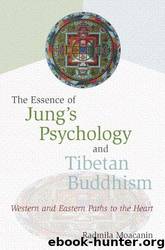The Essence of Jung's Psychology and Tibetan Buddhism: Western and Eastern Paths to the Heart by Radmila Moacanin

Author:Radmila Moacanin
Language: eng
Format: azw3, epub
Tags: Psychology, Eastern, General, Religion, Buddhism, Movements, Tibetan, Jungian
ISBN: 9780861713400
Publisher: Wisdom Publications
Published: 2003-12-15T02:00:46+00:00
THE TIBETAN BOOK OF THE DEAD In his “Psychological Commentary on The Tibetan Book of the Dead,” or Bardo Tödöl, Jung states that this work has been “my constant companion, and to it I owe not only many stimulating ideas and discoveries, but also many fundamental insights.”143The Tibetan Book of the Dead is ostensibly about death and dying, with instructions to the soul of the departed during forty-nine days of peregrination until new birth.
In a modern commentary, basically addressed to the Western world, Chögyam Trungpa Rinpoche calls it “The Tibetan Book of Birth,” thereby making the point that birth and death are fundamental principles that recur constantly in this life.144 The meaning of the word bardo is derived from bar, which means “in between,” and do, which means “island” or “mark.” It is therefore “a sort of landmark which stands between two things,”145 and it refers to an intermediate state, a period of transition. We recognize here the idea of the intermediary, twilight level of consciousness or the twilight period at sunset or dawn, when day turns into night or vice versa. These are borderline states; they are times of crisis, when the tension is at its peak, but they are also the most pregnant psychologically, since they are times when change can most readily occur. Inherent in such states is the opportunity for transformation. In the crack between two worlds—of the living and the dead, of death and rebirth—lies the supreme opportunity. According to the Tibetan Book of the Dead, it is at the moment immediately following death that the mind is capable of attaining liberation. At that moment one reaches the subtlest level of consciousness, the clear-light mind, but because one is not familiar with it, one misses the opportunity to use it to gain enlightenment and instead descends progressively back into the world of the unconscious and a new birth, when the wheel of samsara and suffering starts all over again. In its journey through the underworld, the mind encounters at first beautiful, peaceful, and later frightening, wrathful deities. The teaching of the Book is that these deities are but projections of the mind that need to be recognized as such, that is, as empty forms and illusory images. The confusion is then transformed into transcendental wisdom.
In his commentary, Jung asks us to read the Bardo Tödöl backward. Looking at it that way, it would appear like the course of the individuation process: from the darkness of the unconscious to the clear light at the end. By contrast, the clear light is experienced at the very onset in the journey through the bardo. The path of ascent or descent of awareness is reversed in the Tibetan and Jungian approaches. But to the Buddhist, this would be one and the same, since there is no beginning or end. This may be a problem to Westerners, for it relates to one of the major conceptual differences between Eastern and Western modes of thinking, namely that the West perceives time as linear, whereas in the East time is cyclical—there is the eternal return.
Download
The Essence of Jung's Psychology and Tibetan Buddhism: Western and Eastern Paths to the Heart by Radmila Moacanin.epub
This site does not store any files on its server. We only index and link to content provided by other sites. Please contact the content providers to delete copyright contents if any and email us, we'll remove relevant links or contents immediately.
| Behaviorism | Cognitive Behavioral Therapy |
| Existential | Gestalt |
| Humanistic | Jungian |
| Psychoanalysis | Transpersonal |
The Art of Thinking Clearly by Rolf Dobelli(10214)
The 5 Love Languages: The Secret to Love That Lasts by Gary Chapman(9588)
Mindhunter: Inside the FBI's Elite Serial Crime Unit by John E. Douglas & Mark Olshaker(9187)
Becoming Supernatural by Dr. Joe Dispenza(8119)
Nudge - Improving Decisions about Health, Wealth, and Happiness by Thaler Sunstein(7615)
The Road Less Traveled by M. Scott Peck(7522)
Enlightenment Now: The Case for Reason, Science, Humanism, and Progress by Steven Pinker(7228)
Mastermind: How to Think Like Sherlock Holmes by Maria Konnikova(7223)
Win Bigly by Scott Adams(7094)
The Way of Zen by Alan W. Watts(6504)
Factfulness: Ten Reasons We're Wrong About the World – and Why Things Are Better Than You Think by Hans Rosling(4693)
The State of Affairs by Esther Perel(4637)
Gerald's Game by Stephen King(4571)
Man's Search for Meaning by Viktor Frankl(4420)
The Confidence Code by Katty Kay(4187)
Thinking in Bets by Annie Duke(4152)
The Healing Self by Deepak Chopra(3473)
Hidden Persuasion: 33 psychological influence techniques in advertising by Marc Andrews & Matthijs van Leeuwen & Rick van Baaren(3472)
The Worm at the Core by Sheldon Solomon(3432)
